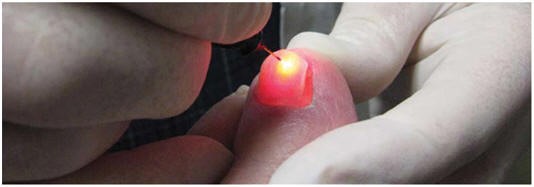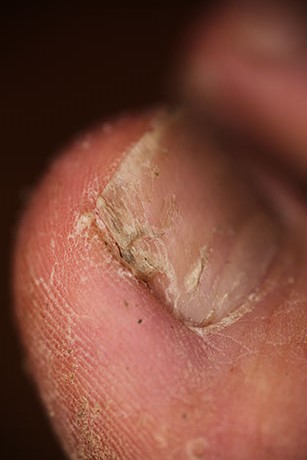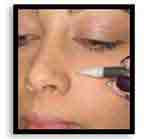Toenail Fungus Removal
How it Works
How Fungus Removal Works
Laser treatments for Toenail Fungus work by using a high-intensity light to selectively destroy the harmful fungus and leaves the surrounding healthy tissue unharmed. The laser kills the fungus, healthy new growth of the nail will come out clean and normal, allowing you to cut off the discolored portions of your nail over time. Our toenails grow very slowly, however, and depending on your nutritional intake, it can take a long time to grow out. So be patient and follow your Post Care instruction sheet that we will send home with you will help you prevent reinfection.
Before your treatment, we would like you to clip and file the nails down as much as possible if they are thick. This will help make the treatment more effective. The fungus is relatively superficial so the laser can target it easier if the nails are thinner.

State of the Art Technologies | How Fungus Removal Works
We use the most advanced lasers on the market. This laser technology represents the gold standard in toenail fungus Removal. With multiple technologies and wavelengths to choose from, we can use the optimum wavelength, customizing the treatment for each patient and each individual.

Before your treatment, we would like you to clip and file your nails down as much as possible if they are thick. This will help make the treatment become more effective. The fungus is relatively superficial so the laser can target it easier if the nail is thinner. We have numerous lasers for each procedure. The nail won’t change back to normal, instead, the growth of the new nail will come out clean, healthy, and normal. Our toenails grow very slowly and can take a long time to grow out. Someones it can take up to a year for our big toe to grow out completely! So be patient and follow our Post Care instruction sheet that we will send home with you. Treatments are usually done every 6-10 weeks.
How Fungus Removal Works | Symptoms of toenail fungus
There are many different symptoms, signs, and types of onychomycosis. The five main types are Distal Lateral Subungual Onychomycosis (DLSO), White Superficial Onychomycosis (WSO), Proximal Subungual Onychomycosis (PSO), Endonyx Onychomycosis (EO), and Candidal Onychomycosis. You may have toenail fungus if your nails have the following symptoms:
- Thickened or discolored
- White, black, yellow or green
- Brittle or crumbly
- Swollen and painful nail bed
- White or yellow patches or lines
- Foul smell
- Abnormal shape and deformities
- Loosening or lifting of the nail
- Loss of luster and shine
- Dirt and debris stuck underneath
- Discomfort wearing shoes and walking from deformities

How Fungus Removal Works| Causes
There are many reasons for toenail fungus (onychomycosis). You may be more prone to getting it if you have:
- Poor circulation, which causes them to grow more slowly
- Diabetes
- Minor skin or nail injuries
- Have immune system problems
- Get manicures/pedicures in nail salons
- Share nail tools
- Wear closed footwear
- Have wet feet for long periods of time
- Go to public pools, shower rooms, gyms,
- Sweat excessively
- Athletes foot
- Wear nail polish
- Ingrown toenails
- Older in age
How Fungus Removal Works | Prevention
You can help get rid of toenail fungus with laser treatments combined with some at-home prevention such as:
- Disinfecting nails tools between uses
- Wear shower shoes in public places such as pools, shower rooms
- Change your socks often
- Soak your feet in 10% bleach solution or apple cider vinegar
- Use a topical medication
- Wash your feet daily and dry them well
- Use sweat-absorbing the powder
- Don’t cut nails too short
- Disinfect shower
- Disinfect shoes
In addition to laser treatment:
We recommended the continual use of a topical antifungal daily to prevent reinfection.
Best Ways to Eliminate Toenail Fungus
What treatment is right for you?
1. Laser Treatment- Quick and painless, our laser has proven effective for the treatment of mild to severe cases of toenail fungus. Laser Treatment is an outpatient visit to a laser spa. The treatment time is generally less than 20 minutes and rarely causes any pain to the patient. The treatment works by using heat and light lasers to selectively destroy the harmful fungus and leaving the surrounding healthy tissue unharmed. In addition the benefits of the laser treatment option, it can also reduce the overall time to heal.
Secondary Options
1. Home Remedies -A few home remedies have been suggested for treating the fungus: Vicks Vapor Rub, vinegar, and even soaking feet in diluted bleach. However, there is no scientific evidence that any one of these is an effective way to cure the fungus. In fact, there have been cases of chemical burns due to the bleach people have tried to use and even the home remedy experts suggest that this could take over a year to see improvements.
- White Vinegar – The most common of the home remedies, which is known to kill bacteria, fight infections, restore skin’s PH balance and prevent the spread of toenail and fingernail fungi due to its antibacterial/fungal properties.
- Salts- Salts are readily available in stores and can be effective in preventing toenail fungus and other bacterias/fungi from occurring and spreading.
- Oregano Oil – This is another popular fingernail and toenail fungus treatment. Oregano oil is known to have antibacterial and antifungal properties making for a good home remedy.
- Baking Soda – Baking soda has not been proven to treat or cure toenail fungus, but it is commonly used to stop fungus from growing. Baking soda can also be used to help foot odor.
- Tea Tree Oil- This oil is known for its antiseptic qualities that help treat infections of the skin. Recently, people have reported Tea Tree Oil as an effective treatment for getting rid of toenail fungus.
- Apple Cider Vinegar- This vinegar is known to treat heartburn, sore throats, acne and can even kill bacteria and prevent the spread of toenail and fingernail fungi.
- Mouthwash – Mouthwash is often used for killing bacteria in the mouth and promoting healthy gums and teeth. It can also be an effective treatment against fungus of the nails.
2. Topical Treatments – Anti-fungal creams, lotions, and sprays are not very effective for the fungus in the toenail. They treat athletes foot pretty well but they do not penetrate deep enough to delete the fungus. Your podiatrist’s office should be able to offer over the counter topical treatments that contain ingredients that are able to carry the medication through the nail in order to reach the fungus. It may take anywhere from 4-6 months to notice a difference.
3. Prescription Topical – Again, depending on the thickness of the nail, topical applications are difficult to penetrate through the fungus. Typically it doesn’t get rid of it, but they help stop the fungus from spreading.
4. Anti-Fungal Nail Polish – One should understand that wearing nail polish will cover and suffocate the nail, preventing it from “airing out”. However, fungus thrives in warm and moist environments. For clients that want to remain wearing nail polish our anti-fungal nail polish is a possible option. Using it as directed for 7 days and then removing and applied again for 7 days until the fungus clears out combined with laser treatments is the best option.
5. Oral Medications – The most commonly prescribed oral medication is Terbinafine ( Lamisil). This can be prescribed for thicker nails that haven’t responded to other treatments. Live function tests must be performed before starting the medication because it gets metabolized through the liver. The medication gets to the root of the nail through the bloodstream and allows the nail to grow healthy and clear of the fungus. One tablet is taken for at least 3 months, and liver enzymes are monitored throughout the treatment.
6. Surgical Removal – surgical removal of that nail can be an option for recurring and difficult staged fungal nails. The thickened fungal nail can be removed and topical application can be used as the new nail starts to grow. Because the area of infection is exposed, the topical treatment is able to kill the fungus more effectively.
The treatment you decide to use will depend upon the severity of the toenail fungus. It is always in your best interest to consult your podiatrist in order to obtain an accurate diagnosis and the best treatment option available to you personally.
7. KeryFlex – A painless Nail Restoration application that can be applied in the office by your provider. It reconstructs the shape, form, and appearance of the patient’s natural nail. If the nail was altered from injury, nail fungus, or other issues, KeryFlex could help.
Keryflex is a strong solution for nails that aids the existing nail in its own growth. The product works instantly to improve cosmetic appearance giving a natural-looking nail.
How long does KeryFlex stay on?
Shortly after the application of KeryFlex, the look of the nail should be enhanced and improved. The KeryFlex results will approximately last six to eight weeks, at which time KeryFlex, is recommended to re-apply. Additionally, you’ll need at least twenty percent of the nail to have it hold on correctly. If you only have a corner of your nail, we can usually put most, but maybe not “all” back on for you.
Important information – Don’t use KeryFlex if you have any of the following:
- Neuropathy (Peripheral)
- Vascular disease (Peripheral)
- Ingrown toenails
- Allergic to any of its ingredients
- Pregnant or nursing
- Arterial insufficiency
- Pigmented lesions on the nail
.












